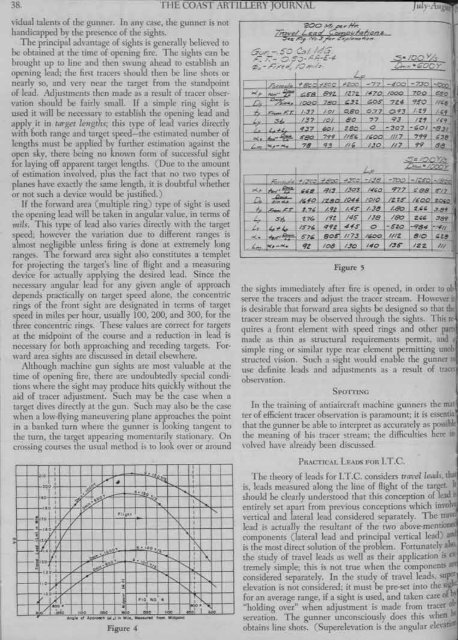July-August - Air Defense Artillery School
July-August - Air Defense Artillery School
July-August - Air Defense Artillery School
You also want an ePaper? Increase the reach of your titles
YUMPU automatically turns print PDFs into web optimized ePapers that Google loves.
38. THE COAST ARTILLERY JOUR:\AL<br />
vidual talents of the gunner. In any case, the gunner is not<br />
handicapped by the presence of the sights.<br />
The principal advantage of sights is generally believed to<br />
be obtained at the time of opening fire. The sights can be<br />
brought up to line and then swung ahead to establish an<br />
opening lead; the first tracers should then be line shots or<br />
nearly so, and very near the target from the standpoint<br />
of lead. A.djustments then made as a result of tracer observation<br />
should be fairly small. If a simple ring sight is<br />
used it will be necessary to establish the opening lead and<br />
applY.it in target le,zgtlzs; this type of lead varies directly<br />
with both range and target speed-the estimated number of<br />
lengths must be applied by further estimation against the<br />
open sky, there being no known form of successful sight<br />
for laying off apparent target lengths. (Due to the amount<br />
of estimation involved, plus the fact that no two types of<br />
planes have exactly the same length, it is doubtful whether<br />
or not such a device would be justified.)<br />
If the forward area (multiple ring) type of sight is used<br />
the opening lead will be taken in angular value, in terms of<br />
mils. This type of lead also varies directly with the target<br />
speed; however the variation due to different ranges is<br />
almost negligible unless firing is done at extremely long<br />
ranges. The forward area sight also constitutes a templet<br />
for projecting the target's line of Hight and a measuring<br />
device for actually applying the desired lead. Since the<br />
necessary angular lead for any given angle of approach<br />
depends practically on target speed alone, the concentric<br />
rings of the front sight are designated in terms of target<br />
speed in miles per hour, usually 100, 200, and 300, for the<br />
three concentric rings. These values are correct for targets<br />
at the midpoint of the course and a reduction in lead is<br />
necessary for both approaching and receding targets. Forward<br />
area sights are discussed in detail elsewhere.<br />
Although machine gun sights are most valuable at the<br />
time of opening fire, there are undoubtedly special conditions<br />
where the sight may produce hits quickly without the<br />
aid of tracer adjustment. Such may be the case when a<br />
target dives directly at the gun. Such may also be the case<br />
when a low-Hying maneuvering plane approaches the point<br />
in a banked turn where the gunner is looking tangent to<br />
the turn, the target appearing momentarily stationary. On<br />
crossing courses the usual method is to look over or around<br />
1<br />
- $. I,<br />
~<br />
S"S'O<br />
--/ /45<br />
r: /7"- :;J. 5''::;_'C ";-£-y!<br />
~.: -h;'-
















